| Western blot (WB): | 1:500-2000 |
| Immunohistochemistry (IHC): | 1:50-400 |
| Immunofluorescence (IF): | 1:50-400 |
| Flow Cytometry (Fixed): | 1:50-200 |
| Enzyme linked immunosorbent assay (ELISA): | 1:100-1000 |
| (Boiling the paraffin sections in 10mM citrate buffer,pH6.0,or PH8.0 EDTA repair liquid for 20 mins is required for the staining of formalin/paraffin sections.) Optimal working dilutions must be determined by end user. | |
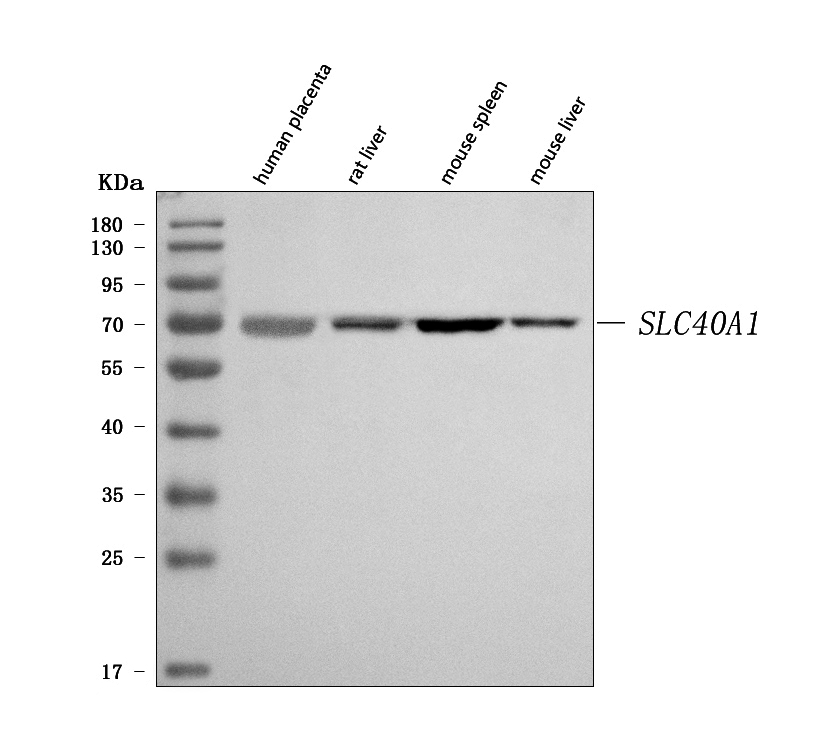
Western blot analysis of anti- SLC40A1 antibody (A01953-2). The sample well of each lane was loaded with 30ug of sample under reducing conditions.
Lane 1: human placenta tissue lysates,
Lane 2: rat liver tissue lysates,
Lane 3: mouse spleen tissue lysates,
Lane 4: mouse liver tissue lysates.
Use rabbit anti- SLC40A1 1:1000, probed with a goat anti-rabbit IgG-HRP secondary antibody. The signal is developed using an Enhanced Chemiluminescent detection (ECL) kit (Catalog#EK1002). A specific band was detected for SLC40A1 at approximately 70KD. The expected band size for SLC40A1 is at 63KD.
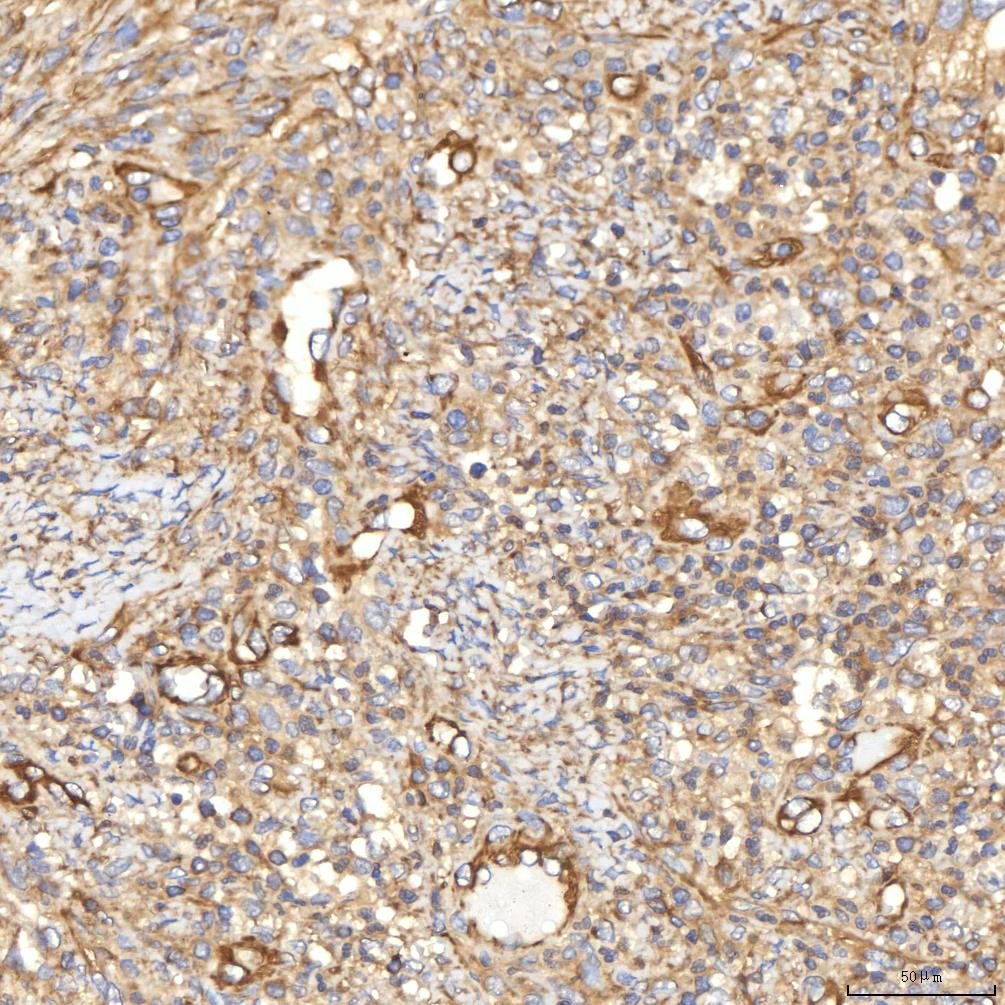
IHC analysis of FPN1/SLC40A1 using anti-FPN1/SLC40A1 antibody (A01953-2).
FPN1/SLC40A1 was detected in a paraffin-embedded section of human larynx squamous cell carcinoma tissue. The tissue section was incubated with rabbit anti-FPN1/SLC40A1 Antibody (A01953-2) at a dilution of 1:200 and developed using HRP Conjugated Rabbit IgG Super Vision Assay Kit (Catalog # SV0002) with DAB (Catalog # AR1027) as the chromogen.
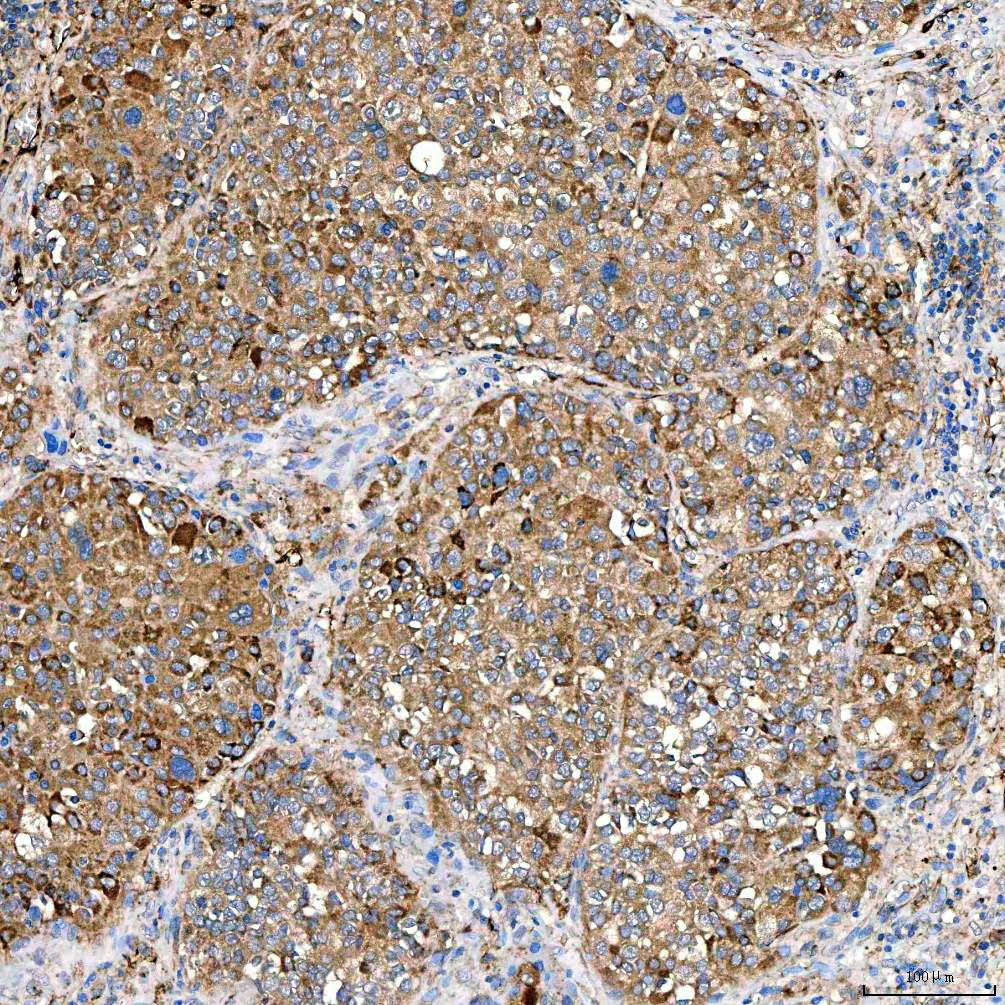
IHC analysis of FPN1/SLC40A1 using anti-FPN1/SLC40A1 antibody (A01953-2).
FPN1/SLC40A1 was detected in a paraffin-embedded section of human liver cancer tissue. The tissue section was incubated with rabbit anti-FPN1/SLC40A1 Antibody (A01953-2) at a dilution of 1:200 and developed using HRP Conjugated Rabbit IgG Super Vision Assay Kit (Catalog # SV0002) with DAB (Catalog # AR1027) as the chromogen.
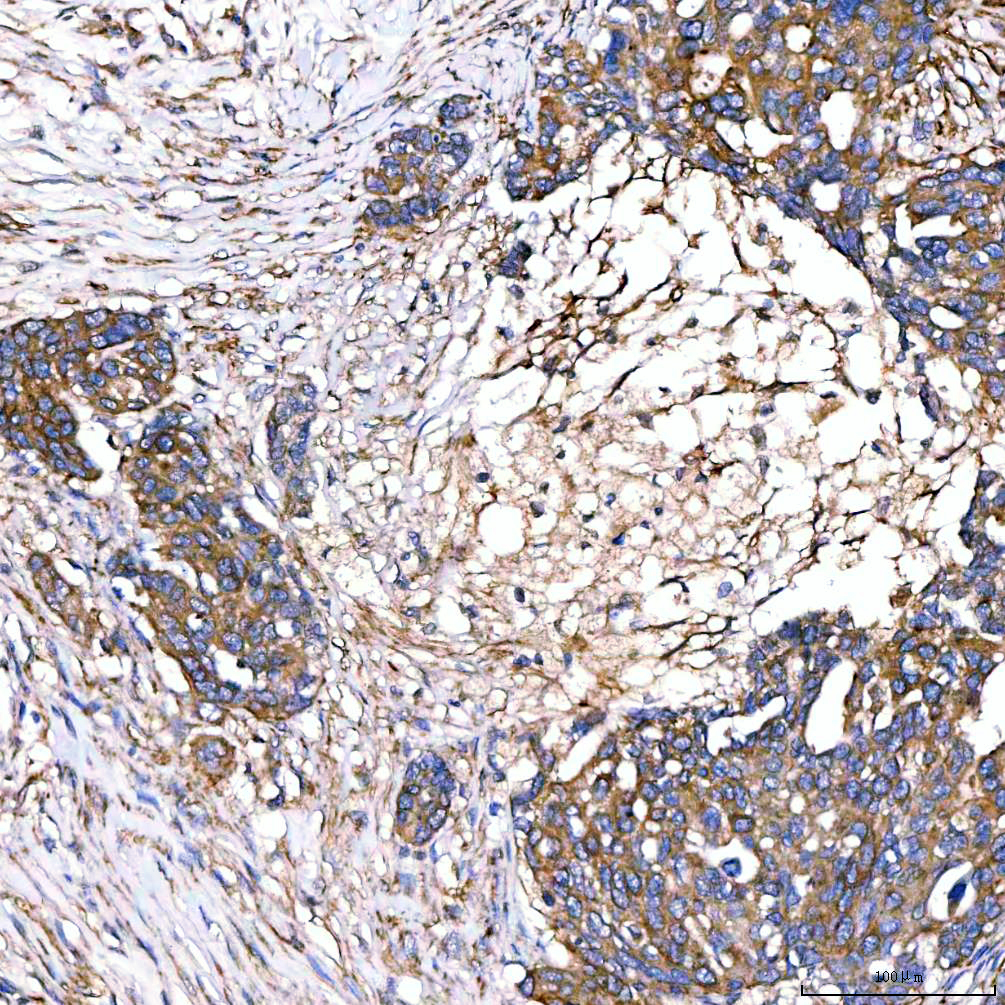
IHC analysis of FPN1/SLC40A1 using anti-FPN1/SLC40A1 antibody (A01953-2).
FPN1/SLC40A1 was detected in a paraffin-embedded section of human ovarian serous adenocarcinoma tissue. The tissue section was incubated with rabbit anti-FPN1/SLC40A1 Antibody (A01953-2) at a dilution of 1:200 and developed using HRP Conjugated Rabbit IgG Super Vision Assay Kit (Catalog # SV0002) with DAB (Catalog # AR1027) as the chromogen.
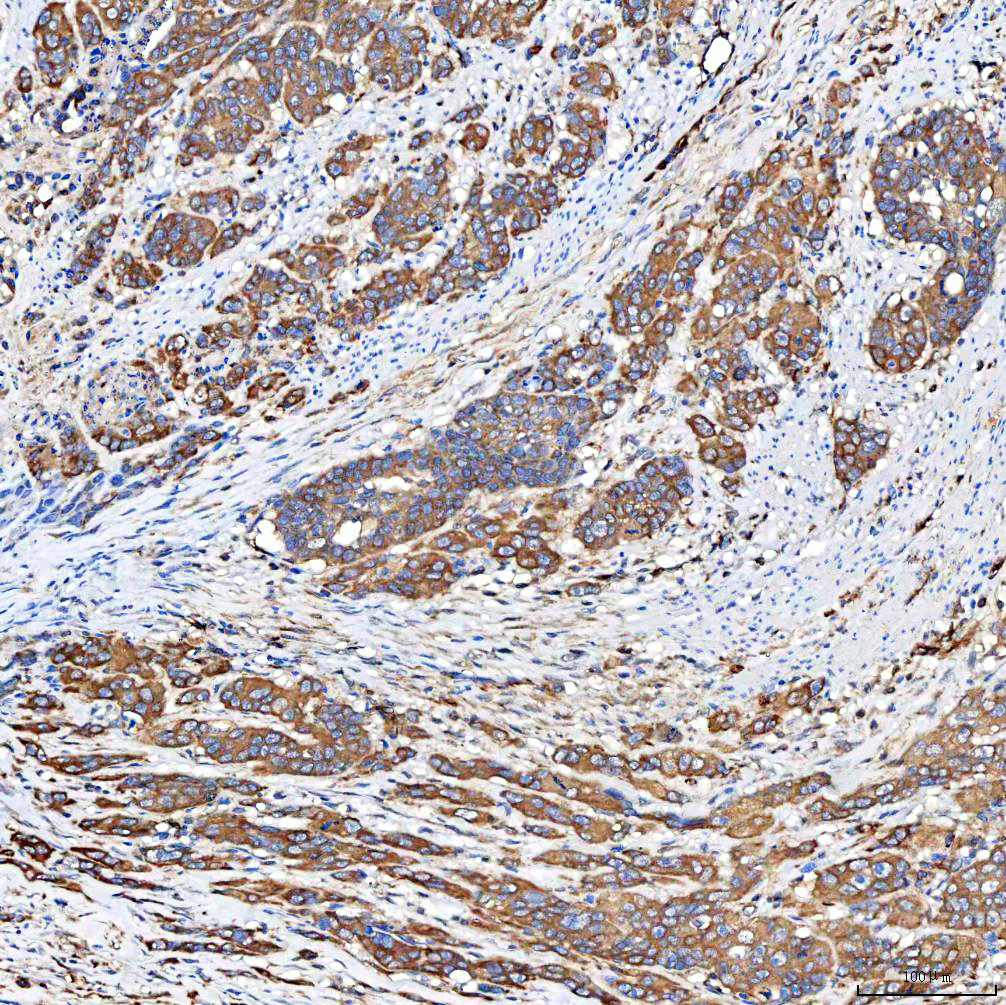
IHC analysis of FPN1/SLC40A1 using anti-FPN1/SLC40A1 antibody (A01953-2).
FPN1/SLC40A1 was detected in a paraffin-embedded section of human prostate adenocarcinoma tissue. The tissue section was incubated with rabbit anti-FPN1/SLC40A1 Antibody (A01953-2) at a dilution of 1:200 and developed using HRP Conjugated Rabbit IgG Super Vision Assay Kit (Catalog # SV0002) with DAB (Catalog # AR1027) as the chromogen.
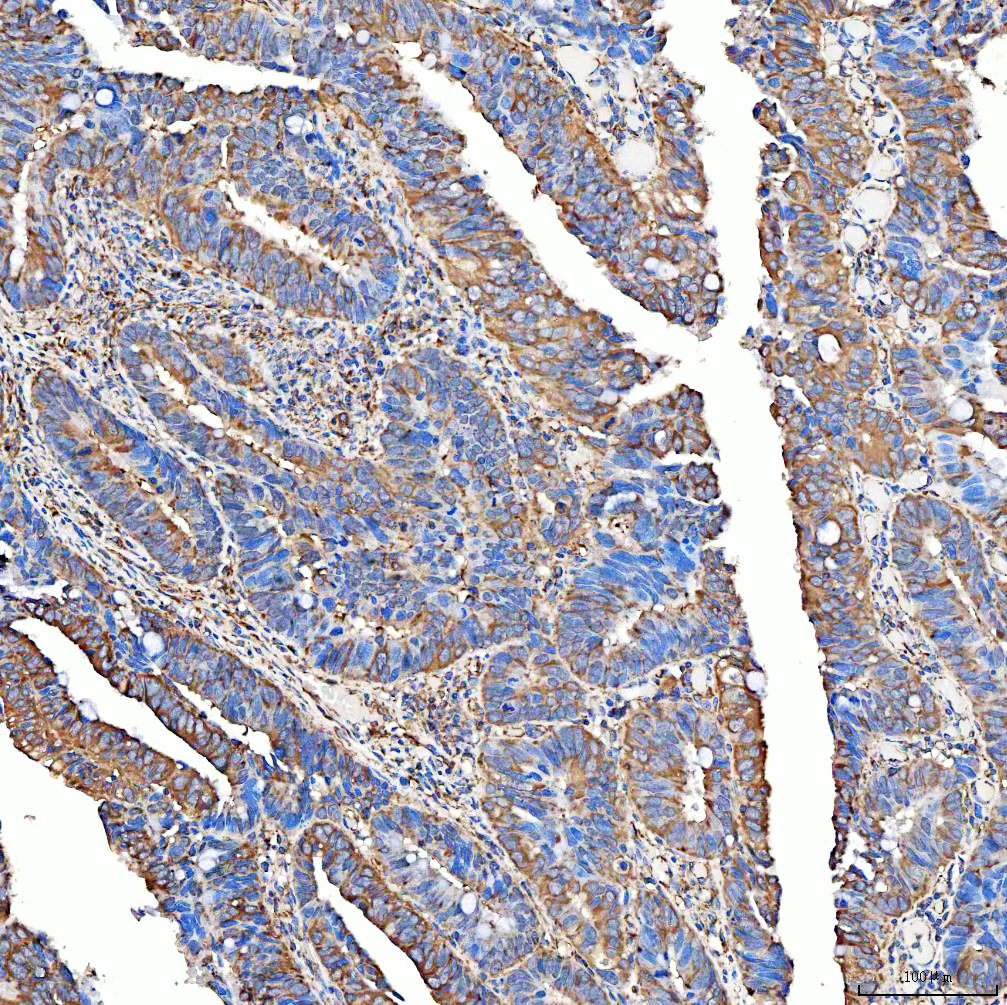
IHC analysis of FPN1/SLC40A1 using anti-FPN1/SLC40A1 antibody (A01953-2).
FPN1/SLC40A1 was detected in a paraffin-embedded section of human rectum adenocarcinoma tissue. The tissue section was incubated with rabbit anti-FPN1/SLC40A1 Antibody (A01953-2) at a dilution of 1:200 and developed using HRP Conjugated Rabbit IgG Super Vision Assay Kit (Catalog # SV0002) with DAB (Catalog # AR1027) as the chromogen.
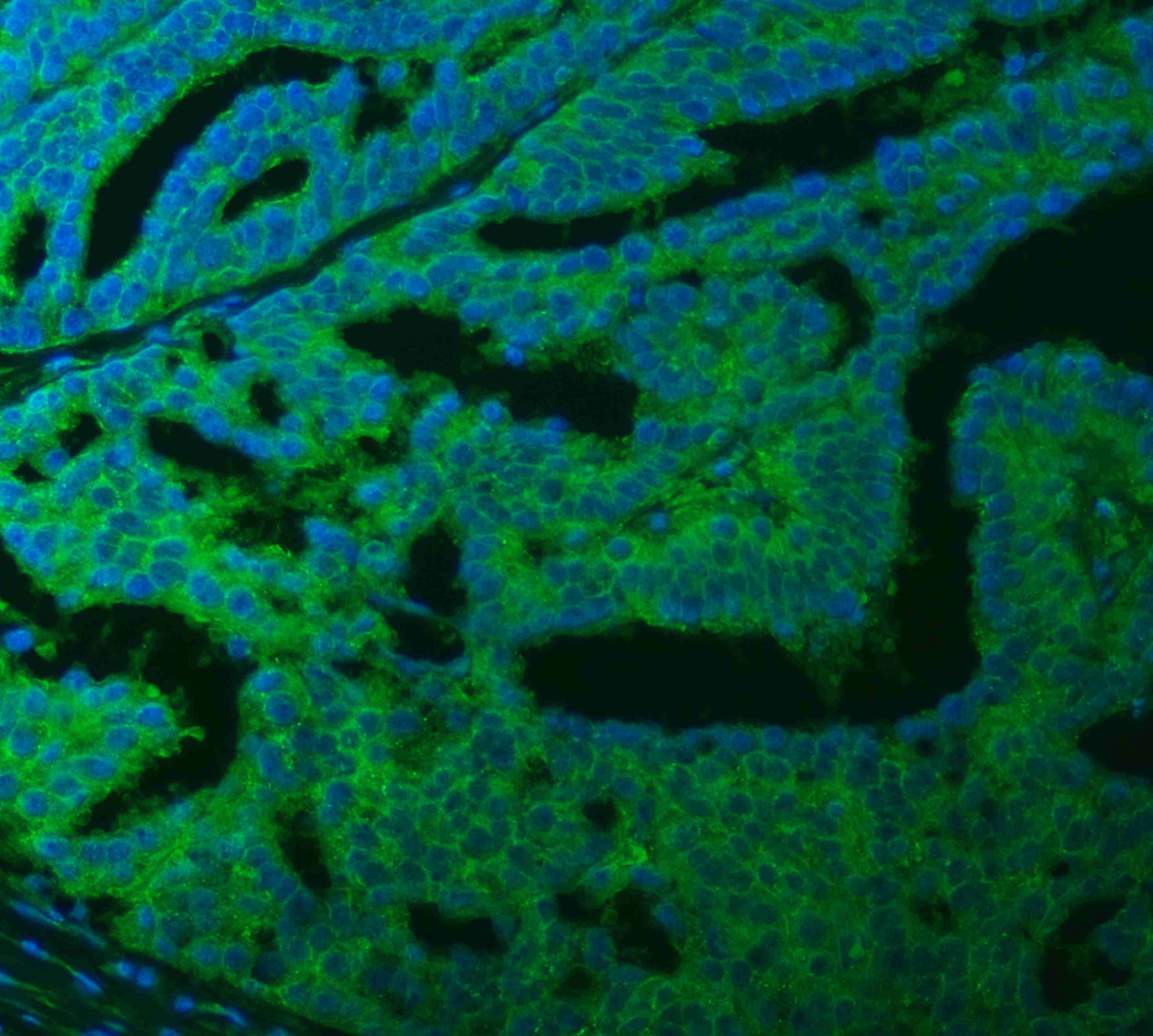
IF analysis of SLC40A1 using anti-SLC40A1 antibody (A01953-2).
SLC40A1 was detected in a paraffin-embedded section of human ovarian cancer tissue. FITC Conjugated AffiniPure Goat Anti-mouse IgG (H+L) Secondary Antibody (green)(Catalog#BA1101) was used as secondary antibody. The section was counterstained with DAPI (Catalog # AR1176) (Blue).
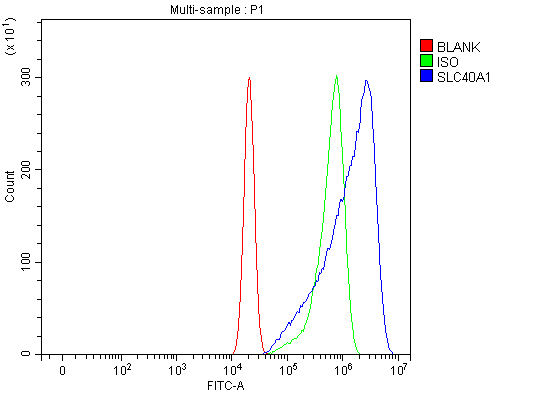
Flow Cytometry analysis of U2OS cells using anti-FPN1/SLC40A1 antibody (A01953-2).
Overlay histogram showing U2OS cells stained with A01953-2 (Blue line). To facilitate intracellular staining, cells were fixed with 4% paraformaldehyde and permeabilized with permeabilization buffer. The cells were blocked with 10% normal goat serum. And then incubated with rabbit anti-FPN1/SLC40A1 Antibody (A01953-2) at 1:100 dilution for 30 min at 20°C. DyLight®488 conjugated goat anti-rabbit IgG (BA1127) was used as secondary antibody at 1:100 dilution for 30 minutes at 20°C. Isotype control antibody (Green line) was rabbit IgG at 1:100 dilution used under the same conditions. Unlabelled sample without incubation with primary antibody and secondary antibody (Red line) was used as a blank control.

Western blot analysis of anti- SLC40A1 antibody (A01953-2). The sample well of each lane was loaded with 30ug of sample under reducing conditions.
Lane 1: human placenta tissue lysates,
Lane 2: rat liver tissue lysates,
Lane 3: mouse spleen tissue lysates,
Lane 4: mouse liver tissue lysates.
Use rabbit anti- SLC40A1 1:1000, probed with a goat anti-rabbit IgG-HRP secondary antibody. The signal is developed using an Enhanced Chemiluminescent detection (ECL) kit (Catalog#EK1002). A specific band was detected for SLC40A1 at approximately 70KD. The expected band size for SLC40A1 is at 63KD.

IHC analysis of FPN1/SLC40A1 using anti-FPN1/SLC40A1 antibody (A01953-2).
FPN1/SLC40A1 was detected in a paraffin-embedded section of human larynx squamous cell carcinoma tissue. The tissue section was incubated with rabbit anti-FPN1/SLC40A1 Antibody (A01953-2) at a dilution of 1:200 and developed using HRP Conjugated Rabbit IgG Super Vision Assay Kit (Catalog # SV0002) with DAB (Catalog # AR1027) as the chromogen.

IHC analysis of FPN1/SLC40A1 using anti-FPN1/SLC40A1 antibody (A01953-2).
FPN1/SLC40A1 was detected in a paraffin-embedded section of human liver cancer tissue. The tissue section was incubated with rabbit anti-FPN1/SLC40A1 Antibody (A01953-2) at a dilution of 1:200 and developed using HRP Conjugated Rabbit IgG Super Vision Assay Kit (Catalog # SV0002) with DAB (Catalog # AR1027) as the chromogen.

IHC analysis of FPN1/SLC40A1 using anti-FPN1/SLC40A1 antibody (A01953-2).
FPN1/SLC40A1 was detected in a paraffin-embedded section of human ovarian serous adenocarcinoma tissue. The tissue section was incubated with rabbit anti-FPN1/SLC40A1 Antibody (A01953-2) at a dilution of 1:200 and developed using HRP Conjugated Rabbit IgG Super Vision Assay Kit (Catalog # SV0002) with DAB (Catalog # AR1027) as the chromogen.

IHC analysis of FPN1/SLC40A1 using anti-FPN1/SLC40A1 antibody (A01953-2).
FPN1/SLC40A1 was detected in a paraffin-embedded section of human prostate adenocarcinoma tissue. The tissue section was incubated with rabbit anti-FPN1/SLC40A1 Antibody (A01953-2) at a dilution of 1:200 and developed using HRP Conjugated Rabbit IgG Super Vision Assay Kit (Catalog # SV0002) with DAB (Catalog # AR1027) as the chromogen.

IHC analysis of FPN1/SLC40A1 using anti-FPN1/SLC40A1 antibody (A01953-2).
FPN1/SLC40A1 was detected in a paraffin-embedded section of human rectum adenocarcinoma tissue. The tissue section was incubated with rabbit anti-FPN1/SLC40A1 Antibody (A01953-2) at a dilution of 1:200 and developed using HRP Conjugated Rabbit IgG Super Vision Assay Kit (Catalog # SV0002) with DAB (Catalog # AR1027) as the chromogen.

IF analysis of SLC40A1 using anti-SLC40A1 antibody (A01953-2).
SLC40A1 was detected in a paraffin-embedded section of human ovarian cancer tissue. FITC Conjugated AffiniPure Goat Anti-mouse IgG (H+L) Secondary Antibody (green)(Catalog#BA1101) was used as secondary antibody. The section was counterstained with DAPI (Catalog # AR1176) (Blue).

Flow Cytometry analysis of U2OS cells using anti-FPN1/SLC40A1 antibody (A01953-2).
Overlay histogram showing U2OS cells stained with A01953-2 (Blue line). To facilitate intracellular staining, cells were fixed with 4% paraformaldehyde and permeabilized with permeabilization buffer. The cells were blocked with 10% normal goat serum. And then incubated with rabbit anti-FPN1/SLC40A1 Antibody (A01953-2) at 1:100 dilution for 30 min at 20°C. DyLight®488 conjugated goat anti-rabbit IgG (BA1127) was used as secondary antibody at 1:100 dilution for 30 minutes at 20°C. Isotype control antibody (Green line) was rabbit IgG at 1:100 dilution used under the same conditions. Unlabelled sample without incubation with primary antibody and secondary antibody (Red line) was used as a blank control.









